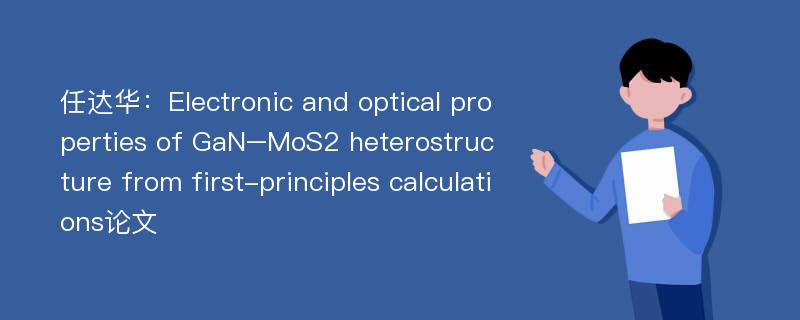
本文主要研究内容
作者任达华,谭兴毅,张腾,张源(2019)在《Electronic and optical properties of GaN–MoS2 heterostructure from first-principles calculations》一文中研究指出:Heterostructures(HSs) have attracted significant attention because of their interlayer van der Waals interactions. The electronic structures and optical properties of stacked GaN–MoS2 HSs under strain have been explored in this work using density functional theory. The results indicate that the direct band gap(1.95 e V) of the Ga N–MoS2 HS is lower than the individual band gaps of both the GaN layer(3.48 e V) and the MoS2 layer(2.03 eV) based on HSE06 hybrid functional calculations. Specifically, the GaN–MoS2 HS is a typical type-II band HS semiconductor that provides an effective approach to enhance the charge separation efficiency for improved photocatalytic degradation activity and water splitting efficiency.Under tensile or compressive strain, the direct band gap of the GaN–MoS2 HS undergoes redshifts. Additionally, the GaN–MoS2 HS maintains its direct band gap semiconductor behavior even when the tensile or compressive strain reaches 5% or-5%. Therefore, the results reported above can be used to expand the application of Ga N–MoS2 HSs to photovoltaic cells and photocatalysts.
Abstract
Heterostructures(HSs) have attracted significant attention because of their interlayer van der Waals interactions. The electronic structures and optical properties of stacked GaN–MoS2 HSs under strain have been explored in this work using density functional theory. The results indicate that the direct band gap(1.95 e V) of the Ga N–MoS2 HS is lower than the individual band gaps of both the GaN layer(3.48 e V) and the MoS2 layer(2.03 eV) based on HSE06 hybrid functional calculations. Specifically, the GaN–MoS2 HS is a typical type-II band HS semiconductor that provides an effective approach to enhance the charge separation efficiency for improved photocatalytic degradation activity and water splitting efficiency.Under tensile or compressive strain, the direct band gap of the GaN–MoS2 HS undergoes redshifts. Additionally, the GaN–MoS2 HS maintains its direct band gap semiconductor behavior even when the tensile or compressive strain reaches 5% or-5%. Therefore, the results reported above can be used to expand the application of Ga N–MoS2 HSs to photovoltaic cells and photocatalysts.
论文参考文献
论文详细介绍
论文作者分别是来自Chinese Physics B的任达华,谭兴毅,张腾,张源,发表于刊物Chinese Physics B2019年08期论文,是一篇关于,Chinese Physics B2019年08期论文的文章。本文可供学术参考使用,各位学者可以免费参考阅读下载,文章观点不代表本站观点,资料来自Chinese Physics B2019年08期论文网站,若本站收录的文献无意侵犯了您的著作版权,请联系我们删除。
